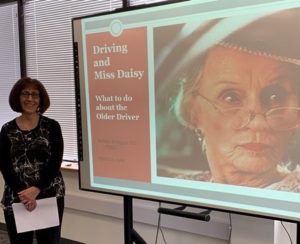May 7
Why are we concerned about older drivers?

Debra A. Kerrigan, MS, OTR/L, from the Drive Safe Program at Newton Wellesley Hospital, visited Springwell to discuss ways to help seniors and their families understand if it is time to curtail or stop driving. While many older adults are safe drivers, the majority of older adults will outlive their ability to drive safely by as much as 7-10 years.
Factors that increase the risk of serious or fatal accidents include: age related physical and cognitive changes, medical conditions, and medication side effects. Slower reaction times, changes to depth perception, slower visual processing speed and slower glare recovery are age related changes that occur for many people. Slower visual processing speed can contribute to poor judgment in making left turns resulting in accidents. When we are younger and drive out of a tunnel into direct sunlight, we feel temporarily blinded but our pupils react quickly to compensate. Kerrigan explained that “glare recovery slows down as we age because our pupils constrict more slowly. 90% of our sensory input is from our vision.” Finally many seniors take multiple medications and interactions or side effects can impair safe driving.
Drivers need to be aware of their overall health to determine if they can drive safely. Because we drive sitting down, it is easy to think that physical strength is not needed. Strength and flexibility are key because one must be able to turn quickly to look over a shoulder and to lift and move the foot quickly from accelerator to brake and press firmly to avoid an accident. Strength is necessary to quickly turn the steering wheel hard in an emergency situation. Technology in cars can be an enhancement but it can fail so the ability to maneuver manually is a must.
With all of these risks, why do we continue to drive as we reach our senior years? Often the answer is tied to the need to fulfill basic needs like grocery shopping or going to the pharmacy or dentist. We don’t want to lose our independence and we don’t want to be isolated from visiting our friends and family. The last thing most want is to depend on family and friends to drive us around.
The goal of driving evaluations and training courses is to keep seniors on the road safely for as long as possible. There are many resources to help older drivers be safe such as Mature Driver Safety Classes (e.g. AAA, AARP) and Advanced Driver Safety Classes (e.g. InControl). Safety classes offer tips, techniques and modifications to help compensate for age related changes that may impact driving. Driving evaluations can help more definitively determine if one should continue driving. An example of this is the Drive Safe program at Newton- Wellesley Hospital (www.nwh.org/drivesafe).
Some warning signs that driving may not be safe include:
- if you are getting honked at by other drivers for driving too slowly or not staying in your lane,
- if you have trouble reading signs until you get very close to them, or feel overwhelmed by road signs and markings while driving
- getting lost on familiar routes,
- speeding or driving too slowly for no reason
- getting new dents or scratches in your vehicle,
- if you have received a ticket for a driving violation, have experienced a near miss or crash recently,
- if you have been advised to limit or stop driving for a health reason, such as suffering from an illness or physical impairment that may affect driving skills
- taking any medications that might affect driving safely or
- if you feel less confident about your driving, especially your strength, flexibility, vision or mental focus.
Talk with a spouse, family member and/or physician about concerns. When it is time to stop driving, finding transportation alternatives will help to ease the transition. Physicians, Council on Aging and other senior care organizations may be helpful with suggesting alternatives to driving. Springwell offers information about some transportation resources.


